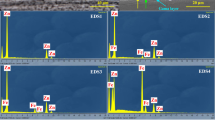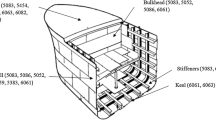Abstract
Test results refute published claims that plates from continuous-cast slabs corrode differently from plates rolled from ingots The continuous casting of steel slabs followed by rolling to plate has become an important source for steels used in marine service. Because of the potential corrosiveness of marine environments toward steel, it is important to know how steel plates produced from continuous-cast slabs compare in corrosion resistance with plates produced from ingots, the customary production method until the adoption of continuous casting about a decade ago.
Similar content being viewed by others
References
G. Wranglen, “Review Article on the Influence of Sulphide Inclusions on the Corrodibility of Fe and Steel,” Corrosion Science, 9, 1969, p. 585.
G. Wranglen, “Active Sulfides and the Pitting Corrosion of Carbon Steels,” Localized Corrosion (Proceedings, Williamsburg, Va., December 1971), Na tional Association of Corrosion Engineers, Houston, Texas, 1974, p. 462.
G. Eklund, “Corrosion Around Slag Inclusion in Steel,” Jernkont. Ann., 154, 1970, p. 321.
H. Adrian, P. Drodten, H.J. Engell, D. Grimme, G. Herbsieb, D. Horstman, S. Menneöh, W. Shenk, “Effect of Metallurgical Development on the Corro sion of Carbon and Low-Alloy Constructional Steels for Ship Building and Harbor Construction,” Corrosion Science, 17, 1977, p. 143.
N. Kaneko, T. Kawawa, I. Matsushima, Y. Ishizu, and Y. Hukuda, “On the Corrosion Characteristics of Continuously Cast Steels,” Nippon Kokan Tech nical Report—Overseas, March 1969.
A. Josefisonand K. Lounamaa, “Comparative Corrosion Tests on Steel Plates Rolled From Continuously Cast Slabs and Plates Rolled From Mould-Cast Ingots,” to be published in Corrosion.
References cited (particularly the work of R. B. Mears) in U. R. Evans, The Corrosion and Oxidation of Metals, Edward Arnold, London, 1960, pp. 935–949.
S. Lundin and B. Utterberg, “The Influence of Microstructure on the Corro sion Resistance of Welded Structural Steels,” Svetsaren in English, 4, No. 2–3, 1968, pp. 14–20.
K. Relander and K. Onnela, “Corrosion Behavior of Heat-Affected Zones in Welded Ships,” Jernkont. Ann., 154, 1970, pp. 173–180.
Additional information
W. PATRICK GALLAGHER roreceived a B.S. in Chemical Engineering from Pennsylvania State University in 1957 and the M.S. and Ph.D. degrees in Inorganic Chemistry from Carnegie-Mellon University in 1961. Dr. Gallagher taught Chemistry at Adelphi University from 1961 to 1964 and worked at Hooker Chemical’s Research Center from 1964 to 1967 in the fields of metal plating and metal protection. Since 1967 he has been a Senior Research Engineer at U.S. Steel Research, Monroeville, Pennsylvania, specializing in the development of new products resistant to corrosion in natural media.
Rights and permissions
About this article
Cite this article
Gallagher, W.P. The corrosion behavior of ship-steel plates rolled from continuous-cast slabs. JOM 30, 5–9 (1978). https://doi.org/10.1007/BF03354365
Published:
Issue Date:
DOI: https://doi.org/10.1007/BF03354365




